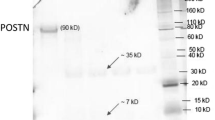Summary
A commercially available radioimmunoassay kit was used to determine aminoterminal procollagen-III peptide (pNcoll III) serum levels in patients with Paget's disease of the bone and control subjects. In patients with Paget's disease pNcoll III concentrations were significantly elevated. They decreased to varying degrees under chronic therapy with human and salmon calcitonin, disodium ethane 1-hydroxy 1,1 diphosphonate (EHDP), or a combination therapy of EHDP and human calcitonin. The results were compared with the effect on traditional biochemical markers of disease activity: serum alkaline phosphatase and urinary hydroxyproline excretion, both of which reacted more acutely to the various therapies than pNcoll III, although pretreatment correlations were close. The most probable source of pNcoll III is not the Pagetic bone per se, but the vascular, fibrous connective tissue replacing normal bone marrow.
Similar content being viewed by others
Abbreviations
- AP:
-
Alkaline phosphatase
- EHDP:
-
Disodium ethane 1-hydroxy 1,1 diphosphonate
- hCT:
-
Human calcitonin
- HP:
-
Hydroxyproline
- pCcoll I:
-
Carboxyterminal procollagen-I peptide
- pNcoll III:
-
Aminoterminal procollagen-III peptide
- RIA:
-
Radioimmunoassay
- sCT:
-
Salmon calcitonin
References
Balleisen L, Gay S, Marx H, Kühn K (1975) Comparative investigation on the influences of human and bovine collagen types I, II and III on the aggregation of human platelets. Klin Wochenschr 53:903–905
Bijvoet O, Hosking D, van Aken J, Will E (1976) The treatment of Paget's disease. Combination of calcitonin and diphosphonates. In: Kanis J (ed) Bone disease and calcitonin symposium. Armour Pharmaceuticals, Eastbourne, England, pp 25–38
Böttger B, Althoff P, Jungmann E, Schöffling K, Strecker H (1982) Prokollagen III Peptid als Verlaufsparameter bei endokrinen Erkrankungen. 88. Verh Dtsch Innere Med, p 1107 (abstract) F
Cheung H, Singer F, Mills B, Nimni M (1980) In vitro synthesis of normal bone (type I) collagen by Paget's disease patients. Proc Soc Exp Biol Med 163:547–552
Demmler K (1974) Die Vaskularisation des Paget Knochens. Dtsch Med Wochenschr 99:91–95
Fessler J, Fessler L (1978) Biosynthesis of procollagen. Ann Rev Biochem 47:129–162
Gay S, Balleisen L, Remberger K, Fietzek P, Adelmann B, Kühn K (1975) Immunohistological evidence of the presence of collagen type III in human arterial walls, arterial thrombi and in leucocytes incubated with collagen in vitro. Klin Wochenschr 53:899–902
Hahn E, Vargas L, Rohde H, Timpl R, Bode J, Martini C (1978) Clinical evaluation of high serum levels of the aminoterminal type III procollagen peptide in fibrotic liver disease. Eur J Clin Invest 8:340–349
Instruction Booklet (1982) Procollagen III peptide radioimmunoassay. Behringwerke, Marburg, FRG
Prockop P, Kivirikko K, Tuderman L, Guzman N (1977) The biosynthesis of collagen and its disorders (part 1). N Engl J Med 301:13–24
Rohde H, Vargas L, Hahn E, Bruguera M, Timpl R (1979) Radioimmunoassay for type III procollagen peptide and its application to human liver disease. Eur J Clin Invest 9:451–459
Rohde H, Hahn E, Timpl R (1978) Radioimmunoassay for amino-terminal procollagen peptides in liver disease. Fresenius Z Anal Chem 290:151–152
Russell RGG, Beard D, Cameron E, Douglas D, Duckworth T, Kanis J, Paterson A, Smith R, Preston C, Smith T, Walton R, Woods C (1982) Diagnose und Behandlung der Osteodystrophia deformans Paget. In: Ziegler R (ed) EHDP: Ein neues therapeutisches Prinzip in Osteopathien und Calciumstoffwechselstörungen. Urban & Schwarzenberg, München, pp 46–90
Simon L, Krane S, Wortman P, Krane I, Kovitz G (1984) Serum levels of type I and III procollagen fragments in Paget's disease of bone. J Clin Endocrinol Metab 58:110–120
Singer FR, Schiller AL, Pyle EB, Krane SM (1978) Paget's disease of bone. In: Avioli LV, Krane SM (eds) Metabolic bone disease. Academic Press, New York, pp 489–513
Taubman M, Kammerman S, Goldberg B (1976) Radioimmunoassay of procollagen in serum of patients with Paget's disease of bone. Proc Soc Exp Biol Med 152:284–287
Timpl R, Risteli R (1981) Radioimmunoassay in studies of connective tissue proteins. In: Furthmayr H (ed) Immunochemistry of the extracellular matrix, vol II, pp 199–236
Timpl R, Wick G, Gay S (1977) Antibodies to distinct types of collagens and procollagens and their application in immunohistology. J Immun Meth 18:165–180
Woodhouse N, Bordier P, Fisher M, Joplin G, Reiner M, Kalu D, Foster G, MacIntyre I (1971) Human calcitonin in the treatment of Paget's bone disease. Lancet I:1139–1143
Author information
Authors and Affiliations
Rights and permissions
About this article
Cite this article
Wilder-Smith, C.H., Raue, F., Holz-Gottswinter, G. et al. Procollagen-III peptide serum levels in Paget's disease of the bone. Klin Wochenschr 65, 174–178 (1987). https://doi.org/10.1007/BF01728230
Received:
Revised:
Accepted:
Issue Date:
DOI: https://doi.org/10.1007/BF01728230




